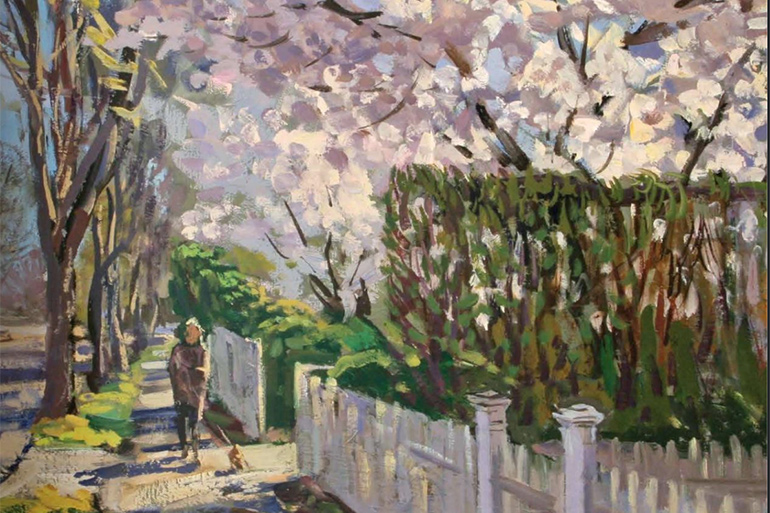Dan's Papers Cover Artist Viktor Butko Paints Spring Scene in Sag Harbor

This week’s March 27, 2020 Dan’s Papers cover artist Viktor Butko talks about his artistic inspiration, what it was like growing up in Russia and how his upbringing informs his art.

What was the inspiration for this piece?
I was inspired by a flowering tree, a play of light and shadow and a spring mood.
Talk about your artistic process.
It all starts with the choice of subject. Sometimes it’s easy, and other times I walk by for a long time and do not notice. The main thing is that an image is born in the mind, which will later be transferred to the canvas. It depends on the mood of nature around you, your mood, feelings, and the influence of the art that you are passionate about in the moment—these are all the components for creating the image.
Sometimes you walk past a place and it looks like it’s not bad, but it doesn’t move you. Then suddenly it lights up with a sunset ray and it is transformed. You already see it in a different light, it excites you and a lot of internal work is going on—the most important thing in my artistic process—and an image is born. Then you continue to think about it, to develop the idea, and edit what is not essential to the design. Sometimes I work with a sketch book and a pencil to look for an image on paper.
This helps a lot, for example, to determine the size of the canvas, the compositional idea, and the great tonal relationships. Then the moment comes, and you understand everything, it’s time to pick up the brush and paint. It also requires certain technical ability, but it is still secondary. In the case of my painting “Spring Time, Sag Harbor,” the impetus for painting was a flowering tree pierced by sunlight and the play of light and shadow.
How did growing up in an artistic family help you develop your craft?
I often visited my grandfather’s studio and watched how he painted. I listened carefully to what they were saying when they were discussing painting. The whole technical process often took place before my eyes. In the summer, when our family moved to the countryside I watched the plein air process.
This informed my own process searching for compositions in the landscape. In the evenings I walked with my grandfather and parents. My grandfather began to stop at a certain place. At first he just stood still, then he stopped and walked around – a little to the left, a little to the right. Then the moment came when he would return with a canvas and easel. I often watched how it works. Then, when I was already in art school, we painted several times together. He gave me advice. Of course, not all of them were immediately clear to me, but now I often remember them, and they help me.
Growing up in a family of artists allowed me to get the necessary foundation of artistic skills and concepts in the most natural way. I continue to develop and strengthen them.
Talk about the Russian influence in your work.
I was born and raised in the USSR, in a family of Russian Soviet artists. I am part of that society and raised on Russian culture. Of course, as an artist, I inherited the traditions of Russian and Soviet art. Since the artist’s works, in my opinion, are a continuation of himself, of his personality, this is most likely the Russian influence in my work.
What do you consider your greatest artistic achievement?
I think this is the professional knowledge and skills that I have acquired at the moment and my experience as a painter in the United States. I am currently preparing for a large solo exhibition in Moscow. This will be the visual manifestation of my achievements. It will be a retrospective of my paintings from art school until today. Pictures from private collections will also be presented.
If you weren’t an artist, what would you be doing?
I think I would be somehow connected with electrical engineering…In my childhood I thought about it, but then art won.
Which artist, living or dead, would you most like to talk with?
With my grandfather, Viktor Chulovich, or with someone from his generation, such as Alexei Gritsay.
Where else can your work be seen?
In art galleries such as the Grenning Gallery in Sag Harbor, Williams Fine Art Dealers in Massachusetts, Watson Gallery in Maine, and in my studio in Waltham, MA. My work can also be seen in private collections in Russia, America, Europe, China, and in our family studio in Moscow.
See more of Viktor Butko’s work at viktorbutko.com.




